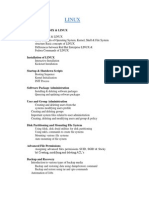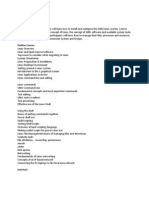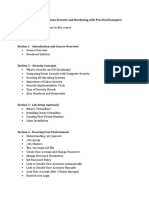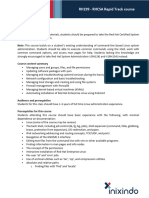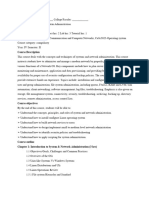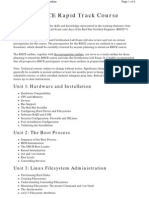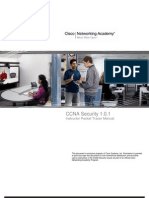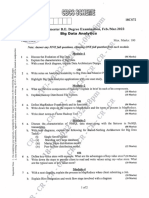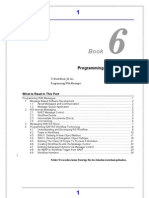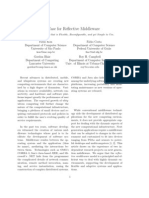Linux Course Details
Linux Course Details
Uploaded by
Azaj IkbalCopyright:
Available Formats
Linux Course Details
Linux Course Details
Uploaded by
Azaj IkbalCopyright
Available Formats
Share this document
Did you find this document useful?
Is this content inappropriate?
Copyright:
Available Formats
Linux Course Details
Linux Course Details
Uploaded by
Azaj IkbalCopyright:
Available Formats
Advanced System & Network Administration using Linux
This course will cover all aspects of RHCE (Red Hat Certified Engineer) Certification and the basics of Linux in detail. This course is also designed for those new bees in Linux, Technocrats, Linux Administrator, Windows Administrator, who want to make the best of Linux capabilities in IT organizations. This course is completely targeted for industrial Environment with In Detailed Practical Approach to LINUX. During this course you will be exposed to Such Linux Capabilities Which are an essential for building great secured Linux Corporate Server Environment.
Lesson 01: Introduction to UNIX & LINUX
History of UNIX and LINUX Linux and GNU Project Operating System Concept, Kernel, Shell & File Basic concepts of Linux Identification of various Linux distributors Planning a Linux Installation Partioning Requirements Linux Installation Method Dual Booting with Windows Operating System installation of Linux with VMware The User Interfaces
Lesson 05: Advanced File Permissions
Explain UNIX/Linux file security & permissions Setting Permissions with chmod Changing User and Group Ownership: chown, chgrp Advance File Permissions: set user id (suid bit), set group id (sgid bit) and sticky bit Creating, modifying and deleting ACLs
Lesson 06: File System Management
The unified Unix file system The Filesystem Hierarchy Standard
Understanding linux file systems Inodes and Directories Managing Partitions: fdisk, parted, partprobe Making File systems: mkfs, mkfs.ext3 Adjusting Filesytem parameters: tune2fs Mount Points and /etc/fstab - explore File System Mounting File systems with mount and Unmount Additional swap space using swapon & swapoff
Lesson 02: Getting started
with Linux
Linux Command line syntax Linux Directory & File System introduction Files, directories and paths Files & Directory handling commands Useful text & shell filters Linking files with Hard link & soft link Redirection and Pipes Introduction to the Linux Text Editor Searching and Replacing Text Using sed for search and replace Searching for text with grep Documentation for commands
Lesson07: Network Management
Understand network device recognition Configuring Network Interfaces Controlling Network Devices: ifup/ifdown Network Tools mii-tool, ifconfig, ethtool etc Static and Dynamic IPV4 Configuration Networking tools: ping, mtr, tcpdump, netstat Network IP aliasing (Device Aliases) Understand IP route configuration Enabling IP Forwarding IPV6 Addressing Overview Local Resolver entry: /etc/hosts Global Resolver entry: /etc/resolv.conf
Lesson 03: Linux Boot Process
System startup procedure Startup & Shutdown Scripts Configuring a boot loader: GRUB Securing single-user mode Explain Linux Boot process Explained Linux Runlevel (0 - 6) The /etc/rc.d/rc.sysinit Program Determining and changing run level Demonstrate Daemon/Service management Control Services using chkconfig, ntsysv etc. Identify Inetd & Xinetd based services
Lesson 08: System Monitoring & Process Management
Demonstrate usage of system monitoring tools What is a process? Parent processes and child processes
Lesson 04: User and Group Administration
User Administration and Management Adding a new user and group Managing user profile files Password management using passwd, chage etc Authentication policies and User Private Groups User Login Activity: Whoami, Who, w, lastb Switching to another user Simple Sudo user, Sudo Examples Granting All Access to Specific Users Extended file permissions including suid, sgid
System and user processes Job control (fg, bg, jobs)
Running programs in the background Suspending processes (Ctrl+Z) Monitoring & Killing processes Killing processes and sending signals a process Process niceness/priority
Lesson 09: Backup, Archive & Recovery
Backup concepts Compressing Files with gzip Other Compression Tools Archiving Files with tar Listing and extracting the Files in tar Archives Backup Media Types of Backup and Strategy Controlling Tape Drives with mt Other Backup Software
Configure BIND as a secondary(slave) DNS server Configure DNS zones Zone Database File Syntax: SOA, A, PTR, NS,CNAME, Alias, and MX-Mail Host Evaluate results of BIND configuration using DIG
Lesson 17: Mail Server (SMTP, POP3, IMAP)
SMTP theory MTA, MDA, MUA Concept Configure Sendmail server to accept internet mail Relay access to my network through access database Mail Forwarding Implement POP3/IMAP services Implement webmail using Squirrel Mail
Lesson 10: CRON Process Scheduling
Controlling access to the 'cron' and 'at' facilities Using 'at' to manage one-off jobs Using the cron system System crontab files Monitoring cron access
Lesson 18: Web Server Implementation
Discuss Apache server's features and concepts Examine Apache - Red Hat HTTPD CONF hierarchy Examine various configuration files Configure IP-based Virtual Hosts Configure Name-based Virtual Hosts Configure .htacess file with directives Implement Apache logging system per virtual host
Using anacron Running commands at particular times Identify various CRON entries and schedules
Lesson 11: Linux Software Management
The Red Hat Package Management system Install & remove package manually using rpm RPM queries and verifying packages Dependency problems and resolution Other RPM features The YUM management tool Configure YUM repositories Accessing repositories from a client Build a simple package
Lesson 19: FTP Server
Implement Very Secure VSFTPD File Transfer Protocol (FTP) services Implement anonymous FTPD Allow or deny for specific FTP Users Disable anonymous access
Lesson 12: Remote Administration
Secure SHELL (SSH) Putty Telnet VNC server/viewer
Lesson 20: Proxy Server (Squid)
Configure web browser to utilize proxy services Grant permissions to permit local hosts to utilize proxy services Configure SQUID Define an ACL for authorized IP networks Apply the ACL using http_access and Test multiple HTTP-based ACLs Configure transparent proxy services Password Authentication based Proxy Server
Lesson 13: NFS Server
NFS Server Configuration and NFS Clients Setup an NFS server and export directories Configure NIS client as part of a domain Review /etc/exports parameters and options Evaluate access to NFS exports
Lesson 21: IPTABLES (Firewall)
Introduction to Firewalls NAT, SNAT, DNAT, PREROUTE and POSTROUTE Implement IP Forwarding between disparate subnets Discuss IPTABLES/Netfilter Concepts Explore default tables and chains
Lesson 14: Samba Server
Implement Linux & Windows Integration via Samba Explore Samba Configuration files Mount Windows shares seamlessly using Samba File System (SMBFS) Samba Client Tools: smbclient, mounts Install Web-based Administration Tool (SWAT)
Lesson 15: DHCP Server
Explain the various steps of the DHCP process Configure global & scope-level DHCP options Configure IP reservations based on MAC addresses Enable Linux DHCP services
Lesson 23: Troubleshooting your system
Recovering the super user password The Rescue Environment Recovering the boot loader (GRUB) Common boot problems and their resolution Troubleshooting Xserver problems Troubleshooting network related problems
Lesson 16: DNS Server with BIND 9
Configure BIND as a primary DNS server Test primary name resolution from Linux hosts
Lesson 24: RAID, LVM and Quota
Understanding different RAID Levels(0,1,5 and 10)
Software RAID Configuration Software RAID Testing and Recovery Discuss Logical Volume Manager (LVM) Creating Logical Volumes Resizing Logical Volumes Logical Volume Manager Snapshots Using LVM Snapshots Quota management - user-based, group-based and disk-based quota implementation Enable file system quota Setting Quotas for users: setquota, edquota, quotaon, quotaoff, quotacheck Quota Concept:Soft Limit, Hard Limit and Grace Period Reporting Quota Status: quota, repquota and warnquota
You might also like
- COBIT 4 To 5 MappingDocument22 pagesCOBIT 4 To 5 MappingSigula Galuh100% (2)
- Data Migration Overall ApproachDocument25 pagesData Migration Overall Approachmark100% (4)
- CyberArk Interview Questions and AnswersDocument11 pagesCyberArk Interview Questions and AnswersKalpesh MNo ratings yet
- A Devops1 PDFDocument9 pagesA Devops1 PDFkiranNo ratings yet
- Linux Foundation's LFCS and LFCE Certification Preparation GuideDocument3 pagesLinux Foundation's LFCS and LFCE Certification Preparation Guiderabirm770% (2)
- RHCE Course Outline PDFDocument7 pagesRHCE Course Outline PDFseenu933No ratings yet
- RH199 RHCSA Rapid Track CourseDocument3 pagesRH199 RHCSA Rapid Track CourseAnonymous t5ZbNeOf69No ratings yet
- CV Md. Azaj Ikbal - Rhce - CcnaDocument4 pagesCV Md. Azaj Ikbal - Rhce - CcnaAzaj IkbalNo ratings yet
- FastTrack To Red Hat Linux 7 System AdministratorDocument3 pagesFastTrack To Red Hat Linux 7 System AdministratorMangesh AbnaveNo ratings yet
- RHCE Exam SyllabusDocument6 pagesRHCE Exam SyllabusKirti PradhanNo ratings yet
- Linux SyllabusDocument2 pagesLinux SyllabusSanjhay RengarajNo ratings yet
- Linux Course SyllabusDocument8 pagesLinux Course SyllabusKosma KosmicNo ratings yet
- (FTNS) Field Technician Networking & Storage: SyllabusDocument23 pages(FTNS) Field Technician Networking & Storage: Syllabusshaik matheenNo ratings yet
- Linux Certified It ProfessionalDocument3 pagesLinux Certified It Professionalapi-246396685No ratings yet
- OpenRHCE SlidesDocument367 pagesOpenRHCE Slidesbu3nyNo ratings yet
- Materi Training Linux 03-09-2012Document9 pagesMateri Training Linux 03-09-2012Kurniawan Setyo NugrohoNo ratings yet
- Linux TrainingDocument10 pagesLinux TrainingPREM SHARMANo ratings yet
- Linux Insight: Course Code - LA011Document18 pagesLinux Insight: Course Code - LA011ThiyagarajanNo ratings yet
- Practical Internet Server Configuration Learn To Build A Fully Functional and Well Secured Enterprise Class Internet Server 1st Edition Robert La LauDocument43 pagesPractical Internet Server Configuration Learn To Build A Fully Functional and Well Secured Enterprise Class Internet Server 1st Edition Robert La Lausteven.perry485No ratings yet
- Linux (Network Admin, RHCE) : ISO 9001:2008 Certified CompanyDocument4 pagesLinux (Network Admin, RHCE) : ISO 9001:2008 Certified CompanyKumar Gaurav SinghNo ratings yet
- Centre For Cloud & Devops Training Society, BikanerDocument2 pagesCentre For Cloud & Devops Training Society, BikanerMehdi HasanNo ratings yet
- RHCE 2015 SyllabusDocument6 pagesRHCE 2015 SyllabusBibin YesbeeNo ratings yet
- Mcse 2003 Course OutlineDocument5 pagesMcse 2003 Course OutlineasifriazzNo ratings yet
- Network and System AdministrationDocument5 pagesNetwork and System AdministrationbarechacNo ratings yet
- Course Objectives: PrerequisitesDocument12 pagesCourse Objectives: PrerequisitessandeepNo ratings yet
- 70-410 NotesDocument150 pages70-410 NotesJaja JajagfNo ratings yet
- Level 1 - User TrainingDocument6 pagesLevel 1 - User Trainingmuiruriandrew3799No ratings yet
- Linux System AdministrationDocument6 pagesLinux System Administrationarunmanoj13550% (1)
- Rhcsa LinuxDocument390 pagesRhcsa LinuxGilberto Ribeiro Ribeiro100% (1)
- RHCSA SyllabusDocument3 pagesRHCSA SyllabusDigital MindsNo ratings yet
- Linux BriefDocument3 pagesLinux BriefMohamed RamahNo ratings yet
- Unix & Linux AdminDocument5 pagesUnix & Linux AdminAnand DhanalakotaNo ratings yet
- LinuxDocument5 pagesLinuxstuzardNo ratings yet
- Redhat Linux SyllabusDocument6 pagesRedhat Linux SyllabusSwapnil AkolkarNo ratings yet
- Syllabus: Complete Linux Security and Hardening With Practical ExamplesDocument4 pagesSyllabus: Complete Linux Security and Hardening With Practical ExamplesM3iatNo ratings yet
- Third Semester Cse 2015-16Document2 pagesThird Semester Cse 2015-16Sufia KhanamNo ratings yet
- LSA Syllabus (E-Next - In)Document3 pagesLSA Syllabus (E-Next - In)FIT160-Singh PratikNo ratings yet
- Linux Administration Practical Workbook-FinalDocument198 pagesLinux Administration Practical Workbook-FinalraunakhgnisNo ratings yet
- RH254Document1 pageRH254paragbaruahNo ratings yet
- Red Hat Enterprise Linux 6 Administration: Real World Skills for Red Hat AdministratorsFrom EverandRed Hat Enterprise Linux 6 Administration: Real World Skills for Red Hat AdministratorsNo ratings yet
- Linux QDocument8 pagesLinux QNidhi PalNo ratings yet
- Cloud CurriculumDocument7 pagesCloud CurriculumVinay KumarNo ratings yet
- RH199 - RHCSA Rapid Track CourseDocument2 pagesRH199 - RHCSA Rapid Track Coursesyst.eNo ratings yet
- Linux@ZoomDocument2 pagesLinux@Zooma06885No ratings yet
- Oracle Linux System Administration: DurationDocument6 pagesOracle Linux System Administration: DurationJeffNo ratings yet
- Updated-SunReach SyllobousDocument7 pagesUpdated-SunReach SyllobouslovemepriyaNo ratings yet
- Complete Linux Training Course To Get Your Dream IT Job - SyllabusDocument5 pagesComplete Linux Training Course To Get Your Dream IT Job - SyllabusHarpreet SinghNo ratings yet
- Networking Career Development ProgramDocument9 pagesNetworking Career Development ProgramaryanNo ratings yet
- AssignmentsDocument3 pagesAssignmentsKeshavNo ratings yet
- D74508GC10 OldDocument2 pagesD74508GC10 OldMangesh AbnaveNo ratings yet
- Redhat Linux ContentDocument7 pagesRedhat Linux ContentSaranNo ratings yet
- Course Contents: Linux Essentials System Administration Network Administration & SecurityDocument4 pagesCourse Contents: Linux Essentials System Administration Network Administration & SecurityJaveed AhamedNo ratings yet
- Linux Training IstituteDocument8 pagesLinux Training Istitutehyd_lonelyNo ratings yet
- CS3910Syllabus PDFDocument3 pagesCS3910Syllabus PDFronaldo maanoNo ratings yet
- Oracle Linux 7: System Administration Ed 1 NEW: DurationDocument6 pagesOracle Linux 7: System Administration Ed 1 NEW: DurationvineetNo ratings yet
- Nasa Course OutlineDocument4 pagesNasa Course OutlinealehegnNo ratings yet
- Course OutlinesDocument4 pagesCourse OutlineshaileNo ratings yet
- RH300 RHCE Rapid Track Course Outline: Unit 1: Hardware and InstallationDocument4 pagesRH300 RHCE Rapid Track Course Outline: Unit 1: Hardware and InstallationRavindra Kumar YadavNo ratings yet
- 2 It302g Linux OsDocument8 pages2 It302g Linux OsAmit DeshaiNo ratings yet
- Important Topics & q1 To q10Document5 pagesImportant Topics & q1 To q10KeshavNo ratings yet
- LInux Training Outline Dec - 2017Document4 pagesLInux Training Outline Dec - 2017Narasimhan ParthNo ratings yet
- Answer DocumedddddddddddddddddddddddddntDocument12 pagesAnswer DocumedddddddddddddddddddddddddntAzaj IkbalNo ratings yet
- Lab Facility:: Zte Cdma Bts and Huawei 3G BtsDocument1 pageLab Facility:: Zte Cdma Bts and Huawei 3G BtsAzaj IkbalNo ratings yet
- Cisco All in One Challenge Lab - 2Document1 pageCisco All in One Challenge Lab - 2Azaj IkbalNo ratings yet
- Ccna Security Instructors ManualDocument54 pagesCcna Security Instructors ManualEusebia Madziwa100% (1)
- Ipv6 Addressing: Md. Manirul IslamDocument12 pagesIpv6 Addressing: Md. Manirul IslamAzaj IkbalNo ratings yet
- Dell VostroDocument1 pageDell VostroAzaj IkbalNo ratings yet
- Squid Proxy Server Centos 5.3Document3 pagesSquid Proxy Server Centos 5.3Azaj IkbalNo ratings yet
- Trunk Port Configuration: Switch 1Document6 pagesTrunk Port Configuration: Switch 1Azaj IkbalNo ratings yet
- Air DistanceDocument1 pageAir DistanceAzaj IkbalNo ratings yet
- N O. Specifications Compliance Brand: Model: Country of Origin Memory: Flash Memory: Firewall Throughput: InterfaceDocument3 pagesN O. Specifications Compliance Brand: Model: Country of Origin Memory: Flash Memory: Firewall Throughput: InterfaceAzaj IkbalNo ratings yet
- Voip Asterisk GetwayDocument10 pagesVoip Asterisk GetwayAzaj IkbalNo ratings yet
- Musgrave Handout Creating and Configuring AutoCAD Plant 3D ProjectsDocument15 pagesMusgrave Handout Creating and Configuring AutoCAD Plant 3D ProjectsVicen Moiron MoyaNo ratings yet
- View Itob View Field Field Data Element Data Type LengthDocument14 pagesView Itob View Field Field Data Element Data Type Lengthkalyani100% (1)
- Hotel ManagementDocument25 pagesHotel ManagementVinay Kanasu100% (4)
- Access Tutorial 1 Creating A Database: ComprehensiveDocument29 pagesAccess Tutorial 1 Creating A Database: Comprehensivesulaiman_butt20058248No ratings yet
- Analytics Cross Selling Retail BankingDocument11 pagesAnalytics Cross Selling Retail Bankingpraveen_bpgcNo ratings yet
- Proposal DSD (AutoRecovered)Document1 pageProposal DSD (AutoRecovered)ARISHA 1240% (1)
- Operating SystemDocument27 pagesOperating SystemVneet ButolaNo ratings yet
- Typical Q&A - SOftware EngineeringDocument81 pagesTypical Q&A - SOftware EngineeringJafar Khan87% (38)
- Datamining and Data Warehouse: By, M.E.Paar RivananDocument13 pagesDatamining and Data Warehouse: By, M.E.Paar Rivanannarayana143No ratings yet
- Cisco Sdwan Design GuideDocument101 pagesCisco Sdwan Design GuideporurrajeshudtNo ratings yet
- Cloud For Beginners Course SlidesDocument147 pagesCloud For Beginners Course Slidesvenkat1235$inkolluNo ratings yet
- Catalina DQDocument49 pagesCatalina DQecho chenNo ratings yet
- Symantec Backup Exe Admin GuideDocument1,342 pagesSymantec Backup Exe Admin GuidedibpalNo ratings yet
- VTU Exam Question Paper With Solution of 18CS72 Big Data and Analytics Feb-2022-Dr. v. VijayalakshmiDocument25 pagesVTU Exam Question Paper With Solution of 18CS72 Big Data and Analytics Feb-2022-Dr. v. VijayalakshmiWWE ROCKERSNo ratings yet
- NAST Programando Con Mensajes PDFDocument34 pagesNAST Programando Con Mensajes PDFRoberto MartínezNo ratings yet
- Ivend Retail 6.6 - Installation GuideDocument47 pagesIvend Retail 6.6 - Installation Guidesofyan123No ratings yet
- Modifying and Using Engineering Library Data: ProblemDocument5 pagesModifying and Using Engineering Library Data: Problemselamawit workinehNo ratings yet
- Higher Education's Top 10 Strategic Technologies For 2016: Educause Center For Analysis and ResearchDocument55 pagesHigher Education's Top 10 Strategic Technologies For 2016: Educause Center For Analysis and ResearchElvis MendesNo ratings yet
- PasswordDocument4 pagesPasswordevx41611No ratings yet
- The Case For Reflective MiddlewareDocument10 pagesThe Case For Reflective Middlewarepj4allNo ratings yet
- Shreeyash College of Engineering and Technology (Polytechnic), Chh. Sambhajinagar Micro-Project ReportDocument17 pagesShreeyash College of Engineering and Technology (Polytechnic), Chh. Sambhajinagar Micro-Project Reportrk.upk2345678No ratings yet
- Instructions:: Lab7 and Lab8Document5 pagesInstructions:: Lab7 and Lab8sapna thakurNo ratings yet
- Dbms TextbookDocument109 pagesDbms TextbookSeema swathiNo ratings yet
- Static Analysis (Coverity) Architecture Analysis: Product OverviewDocument2 pagesStatic Analysis (Coverity) Architecture Analysis: Product OverviewAkmaruddin Bin JofriNo ratings yet
- Cybersecurity Awareness Presentation 17 May 22Document18 pagesCybersecurity Awareness Presentation 17 May 22shanessa castromayorNo ratings yet
- Priv Access Management Win16Document11 pagesPriv Access Management Win16NavneetMishraNo ratings yet













